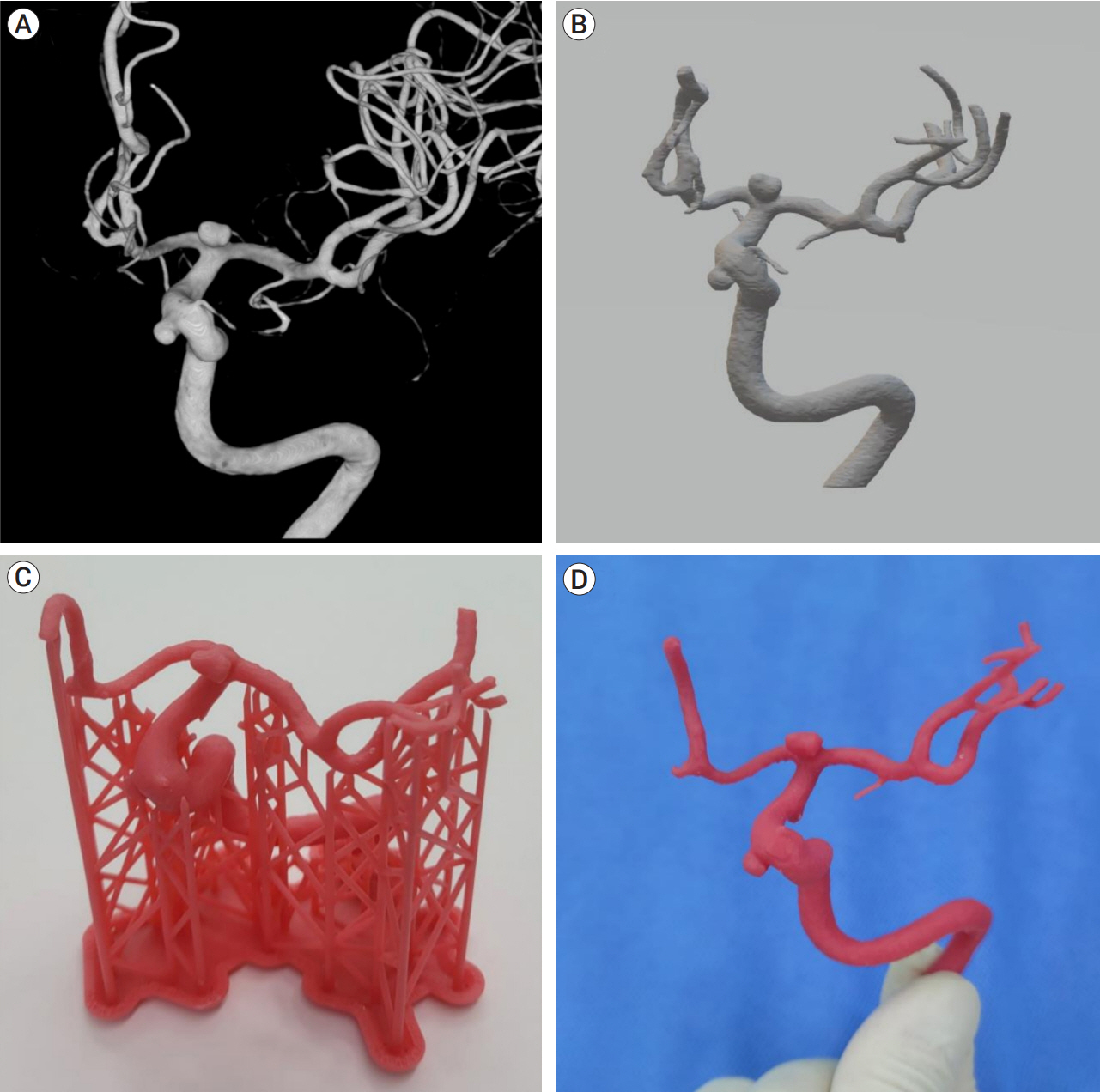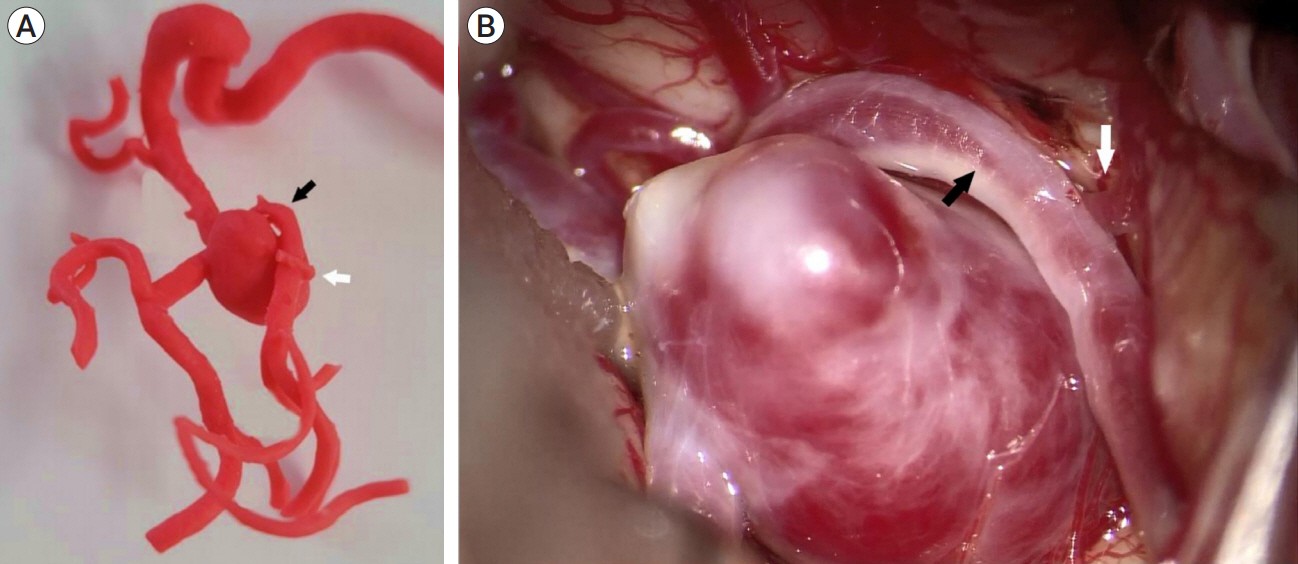J Cerebrovasc Endovasc Neurosurg.
2023 Mar;25(1):19-27. 10.7461/jcen.2022.E2022.09.002.
Efficacy of 3D-printed simulation models of unruptured intracranial aneurysms in patient education and surgical simulation
- Affiliations
-
- 1Department of Neurosurgery, Dongsan Medical Center, Keimyung University School of Medicine, Daegu, Korea
- 2Department of Biomedical Engineering, School of Medicine, Keimyung University, Daegu, Korea
- KMID: 2540804
- DOI: http://doi.org/10.7461/jcen.2022.E2022.09.002
Abstract
Objective
The purpose of this study was to determine the efficacy of a 3D-printed aneurysm simulation model (3DPM) in educating patients and improving physicians’ comprehension and performance.
Methods
This prospective study involved 40 patients who were diagnosed with unruptured intracranial aneurysms (UIAs) and scheduled for surgical clipping or endovascular coiling and randomly divided into two groups (the 3DPM group and the non-3DPM group). The 3DPM was used in preoperative consultation with patients and intraoperatively referenced by surgeons. The patients, 7 neurosurgical residents, and 10 surgeons completed questionnaires (5-point Likert scale) to determine the usefulness of the 3DPM.
Results
Patients in the 3DPM group had significantly higher scores in terms of their understanding of the disease (mean 4.85 vs. 3.95, p<0.001) and the treatment plan (mean 4.85 vs. 4.20, p=0.005) and reported higher satisfaction during consultation (5.0 vs. 4.60, p=0.036) than patients in the non-3DPM group. During patient consultation, 3DPMs were most useful in improving doctor–patient communication (mean 4.57, range 4-5). During clipping surgery, the models were most useful in assessing adjacent arteries (mean 4.9, range 4-5); during endovascular coiling, they were especially helpful in microcatheter shaping (mean 4.7, range 4-5).
Conclusions
In general, 3DPMs are beneficial in educating patients and improving the physician’s performance in terms of surgical clipping and endovascular coiling of UIAs.
Figure
Reference
-
1. Błaszczyk M, Jabbar R, Szmyd B, Radek M. 3D printing of rapid, low-cost and patient-specific models of brain vasculature for use in preoperative planning in clipping of intracranial aneurysms. J Clin Med. 2021; Mar. 10(6):1201.2. Brown RD, Broderick JP. Unruptured intracranial aneurysms: epidemiology, natural history, management options, and familial screening. Lancet Neurol. 2014; Apr. 13(4):393–404.3. Chawla S, Devi S, Calvachi P, Gormley WB, Rueda-Esteban R. Evaluation of simulation models in neurosurgical training according to face, content, and construct validity: a systematic review. Acta Neurochir (Wien). 2022; Apr. 164(4):947–66.4. Chen C, Cai L, Zheng W, Wang J, Guo X, Chen H. The efficacy of using 3D printing models in the treatment of fractures: a randomised clinical trial. BMC Musculoskelet Disord. 2019; Feb. 20(1):65.5. Cogswell PM, Rischall MA, Alexander AE, Dickens HJ, Lanzino G, Morris JM. Intracranial vasculature 3D printing: review of techniques and manufacturing processes to inform clinical practice. 3D Print Med. 2020; Aug. 6(1):18.6. Damon A, Clifton W, Valero-Moreno F, Quinones-Hinojosa A. Cost-effective method for 3-dimensional printing dynamic multiobject and patient-specific brain tumor models: technical note. World Neurosurg. 2020; Aug. 140:173–9.7. Dho Y-S, Lee D, Ha T, Ji SY, Kim KM, Kang H, et al. Clinical application of patient-specific 3D printing brain tumor model production system for neurosurgery. Sci Rep. 2021; Mar. 11(1):7005.8. Faraj MK, Hoz SS, Mohammad AJ. The use of three-dimensional anatomical patient-specific printed models in surgical clipping of intracranial aneurysm: a pilot study. Surg Neurol Int. 2020; Nov. 11:381.9. Gabriel RA, Kim H, Sidney S, McCulloch CE, Singh V, Johnston SC, et al. Ten-year detection rate of brain arteriovenous malformations in a large, multiethnic, defined population. Stroke. 2010; Jan. 41(1):21–6.10. Heinrich MA, Bansal R, Lammers T, Zhang YS, Michel Schiffelers R, Prakash J. 3D-bioprinted mini-brain: a glioblastoma model to study cellular interactions and therapeutics. Adv Mater. 2019; Apr. 31(14):e1806590.11. Ishibashi T, Takao H, Suzuki T, Yuki I, Kaku S, Kan I, et al. Tailor-made shaping of microcatheters using three-dimensional printed vessel models for endovascular coil embolization. Comput Biol Med. 2016; Oct. 77:59–63.12. Janes D, Boone D, Dubrowski A. “It’s only brain surgery”: using 3D printing and simulation to prepare rural physicians for the management of acute epidural hematoma. Cureus. 2020; Oct. 12(10):e11236.13. Kim PS, Choi CH, Han IH, Lee JH, Choi HJ, Lee JI. Obtaining informed consent using patient specific 3D printing cerebral aneurysm model. J Korean Neurosurg Soc. 2019; Jul. 62(4):398–404.14. Kimura T, Morita A, Nishimura K, Aiyama H, Itoh H, Fukaya S, et al. Simulation of and training for cerebral aneurysm clipping with 3-dimensional models. Neurosurgery. 2009; Oct. 65(4):719–25. discussion 725.15. Kosterhon M, Neufurth M, Neulen A, Schäfer L, Conrad J, Kantelhardt SR, et al. Multicolor 3D printing of complex intracranial tumors in neurosurgery. J Vis Exp. 2020; Jan. (155).16. Mashiko T, Otani K, Kawano R, Konno T, Kaneko N, Ito Y, et al. Development of three-dimensional hollow elastic model for cerebral aneurysm clipping simulation enabling rapid and low cost prototyping. World Neurosurg. 2015; Mar. 83(3):351–61.17. Nagassa RG, McMenamin PG, Adams JW, Quayle MR, Rosenfeld JV. Advanced 3D printed model of middle cerebral artery aneurysms for neurosurgery simulation. 3D Print Med. 2019; Aug. 5(1):11.18. Namba K, Higaki A, Kaneko N, Mashiko T, Nemoto S, Watanabe E. Microcatheter shaping for intracranial aneurysm coiling using the 3-dimensional printing rapid prototyping technology: preliminary result in the first 10 consecutive cases. World Neurosurg. 2015; Jul. 84(1):178–86.19. Ploch CC, Mansi CSSA, Jayamohan J, Kuhl E. Using 3D printing to create personalized brain models for neurosurgical training and preoperative planning. World Neurosurg. 2016; Jun. 90:668–74.20. Randazzo M, Pisapia JM, Singh N, Thawani JP. 3D printing in neurosurgery: a systematic review. Surg Neurol Int. 2016; Nov. 7(Suppl 33):S801–9.21. Rengier F, Mehndiratta A, von Tengg-Kobligk H, Zechmann CM, Unterhinninghofen R, Kauczor H-U, et al. 3D printing based on imaging data: review of medical applications. Int J Comput Assist Radiol Surg. 2010; Jul. 5(4):335–41.22. Ryan JR, Almefty KK, Nakaji P, Frakes DH. Cerebral aneurysm clipping surgery simulation using patient-specific 3D printing and silicone casting. World Neurosurg. 2016; Apr. 88:175–81.23. Vlak MH, Algra A, Brandenburg R, Rinkel GJ. Prevalence of unruptured intracranial aneurysms, with emphasis on sex, age, comorbidity, country, and time period: a systematic review and meta-analysis. Lancet Neurol. 2011; Jul. 10(7):626–36.24. Wang L, Ye X, Hao Q, Ma L, Chen X, Wang H, et al. Three-dimensional intracranial middle cerebral artery aneurysm models for aneurysm surgery and training. J Clin Neurosci. 2018; Apr. 50:77–82.
- Full Text Links
- Actions
-
Cited
- CITED
-
- Close
- Share
- Similar articles
-
- 3D-Printed Disease Models for Neurosurgical Planning, Simulation, and Training
- Obtaining Informed Consent Using Patient Specific 3D Printing Cerebral Aneurysm Model
- Corrective Surgery Using Virtual Surgical Simulation and a Three-Dimensional Printed Osteotomy Guide: A Case Report
- Guideline for Management of Unruptured Intracranial Aneurysms: Preliminary Report
- Congenital Heart Surgery Skill Training Using Simulation Models: Not an Option but a Necessity



